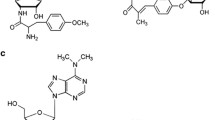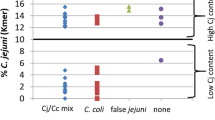Abstract
Full-length tlyA gene and its adjacent genetic loci from the urease-positive thermophilic Campylobacter (UPTC) CF89-12 [approximately 15,000 base pairs (bp) in length], as well as a reference strain Campylobacter lari RM2100 (approximately 9,000 bp), were analyzed. The possible open-reading frame of tlyA from UPTC CF89-12 was shown to have 720 bp with a calculated molecular mass of approximately 26.7 kDa. Using a primer pair designed in silico, a total of approximately 1.1 kbp consisting of putative promoter region, structural gene for tlyA, and its adjacent genetic loci were identified in all 17 C. lari isolates [n = 13 for UPTC; n = 4 for urease-negative (UN) C. lari]. Although sequence differences were demonstrated at approximately 20 loci within the 90 bp non-coding (NC) region, including the putative promoter structure candidates immediately upstream of the tlyA gene among the 18 isolates including C. lari RM2100, no sequence differences were identified within the NC region among the five UN C. lari isolates examined. A start codon ATG and a probable ribosome-binding site, AGGC(T)GG(A), for the tlyA gene were identified in all 18 isolates, including C. lari RM2100. The putative intrinsic ρ-independent transcriptional terminator structure candidate was also identified for the tlyA gene in both UPTC CF89-12 and C. lari RM2100. Additionally, the hemolysis assay was performed with some of the C. lari isolates. The tlyA gene nucleotide sequence data may possibly be useful for discrimination between UN C. lari and UPTC organisms, as well as for the differentiation among the four thermophilic Campylobacter species.





Similar content being viewed by others
References
Arenas NE, Salazar LM, Soto CY, Vizcaino C, Patarroyo ME, Patarroyo MA, Gomez A (2011) Molecular modeling and in silico characterization of Mycobacterium tuberculosis TlyA: possible misannotation of this tubercle bacilli-hemolysin. BMC Struct Biol 11:16. doi:10.1186/1472-6807-11-16
Benjamin L (2000) Genes VII. Oxford University Press, Oxford
Benjamin J, Leaper S, Owen RJ, Skirrow MB (1983) Description of Campylobacter laridis, a new species comprising the nalidixic acid resistant thermophilic Campylobacter (NARTC) group. Curr Microbiol 8:231–238
Bezian MC, Ribou G, Barberis-Giletti C, Mégraud F (1990) Isolation of a urease positive thermophilic variant of Campylobacter lari from a patient with urinary tract infection. Eur J Clin Microbiol Infect Dis 9:895–897
Blaser MJ, Taylor DN, Feldman RA (1983) Epidemiology of Campylobacter jejuni infections. Epidemiol Rev 5:157–176
Bolton FJ, Holt A, Hutchinson DN (1985) Urease-positive thermophilic campylobacters. Lancet i:1217–1218
Braun V, Focareta T (1991) Pore-forming bacterial protein hemolysins (cytolysins). Crit Rev Microbiol 18:115–158
Debruyne L, On SL, De Brandt E, Vandamme P (2009) Novel Campylobacter lari-like bacteria from humans and molluscs: description of Campylobacter peloridis sp. nov., Campylobacter lari subsp. concheus subsp. nov. and Campylobacter lari subsp. lari sub sp. nov. Int J Syst Evol Microbiol 59:1126–1132
Endtz HP, Vliegenthart JS, Vandamme P, Weverink HW, van den Braak NP, Verbrugh HA, van Belkum A (1996) Genotypic diversity of Campylobacter lari isolated from mussels and oysters in The Netherlands. Int J Food Microbiol 34:79–88
Fouts DE, Mongodin EF, Mandrell RE, Miller WG, Rasko DA, Ravel J, Brinkac LM, DeBoy RT, Parker CT, Daugherty SC, Dodson RJ, Durkin AS, Madupu R, Sullivan SA, Shetty JU, Ayodeji MA, Shvartsbeyn A, Schatz MC, Badger JH, Fraser CM, Nelson KE (2005) Major structural differences and novel potential virulence mechanisms from the genomes of multiple Campylobacter species. PLoS Biol 3:e15
Harrington CS, Thomson-Carter FM, Carter PE (1997) Evidence for recombination in the flagellin locus of Campylobacter jejuni: implications for the flagellin gene typing scheme. J Clin Microbiol 35:2386–2392
Hirayama J, Tazumi A, Hayashi K, Tasaki E, Kuribayashi T, Moore JE, Millar BC, Matsuda M (2011) A phylogenetic comparison of urease-positive thermophilic Campylobacter (UPTC) and urease-negative (UN) C. lari. J Basic Microbiol 51:269–278
Hsu T, Hutto DL, Minion FC, Zuerner RL, Wannemuehler MJ (2001) Cloning of a beta-hemolysin gene of Brachyspira (Serpulina) hyodysenteriae and its expression in Escherichia coli. Infect Immun 69:706–711
Kaneko A, Matsuda M, Miyajima M, Moore JE, Murphy PG (1999) Urease-positive thermophilic strains of Campylobacter isolated from seagulls (Larus spp.). Lett Appl Microbiol 29:7–9
Martino MC, Stabler RA, Zhang ZW, Farthing MJ, Wren BW, Dorrell N (2001) Helicobacter pylori pore-forming cytolysin orthologue TlyA possesses in vitro hemolytic activity and has a role in colonization of the gastric mucosa. Infect Immun 69:1697–1703
Martinot M, Jaulhac B, Moog R, De Martino S, Kehrli P, Monteil H, Piemont Y (2001) Campylobacter lari bacteremia. Clin Microbiol Infect 7:96–97
Matsuda M, Moore JE (2004) Urease-positive thermophilic Campylobacter species. Appl Environ Microbiol 70:4415–4418
Matsuda M, Kaneko A, Fukuyama M, Itoh T, Shingaki M, Inoue M, Moore JE, Murphy PG, Ishida Y (1996) First finding of urease-positive thermophilic strains of Campylobacter in river water in the Far East, namely, in Japan, and their phenotypic and genotypic characterization. J Appl Bacteriol 81:608–612
Matsuda M, Shibuya T, Itoh Y, Takiguchi M, Furuhata K, Moore JE, Murayama O, Fukuyama M (2002) First isolation of urease-positive thermophilic Campylobacter (UPTC) from crows (Corvus levaillantii) in Japan. Int J Hyg Environ Health 205:321–324
Matsuda M, Kaneko A, Stanley T, Millar BC, Miyajima M, Murphy PG, Moore JE (2003) Characterization of urease-positive thermophilic Campylobacter subspecies by multilocus enzyme electrophoresis typing. Appl Environ Microbiol 69:3308–3310
Mégraud F, Chevrier D, Desplaces N, Sedallian A, Guesdon JL (1988) Urease-positive thermophilic campylobacter (Campylobacter laridis variant) isolated from an appendix and from human feces. J Clin Microbiol 26:1050–1051
Miller WG, Wang G, Binnewies TT, Parker CT (2008) The complete genome sequence and analysis of the human pathogen Campylobacter lari. Foodborne Pathog Dis 5:371–386
Muir S, Koopman MB, Libby SJ, Joens LA, Heffron F, Kusters JG (1992) Cloning and expression of a Serpula (Treponema) hyodysenteriae hemolysin gene. Infect Immun 60:529–535
Nachamkin I, Stowell C, Skalina D, Jones AM, Hoop RM 2nd, Smibert RM (1984) Campylobacter laridis causing bacteremia in an immunosuppressed patient. Ann Intern Med 101:55–57
On SL, Atabay HI, Corry JE, Harrington CS, Vandamme P (1998) Emended description of Campylobacter sputorum and revision of its infrasubspecific (biovar) divisions, including C. sputorum biovar paraureolyticus, a urease-producing variant from cattle and humans. Int J Syst Bacteriol 48:195–206
Owen RJ, Costas M, Sloss L, Bolton FJ (1988) Numerical analysis of electrophoretic protein patterns of Campylobacter laridis and allied thermophilic campylobacters from the natural environment. J Appl Bacteriol 65:69–78
Parkhill J, Wren BW, Mungall K, Ketley JM, Churcher C, Basham D, Chillingworth T, Davies RM, Feltwell T, Holroyd S, Jagels K, Karlyshev AV, Moule S, Pallen MJ, Penn CW, Quail MA, Rajandream MA, Rutherford KM, van Vliet AH, Whitehead S, Barrell BG (2000) The genome sequence of the food-borne pathogen Campylobacter jejuni reveals hypervariable sequences. Nature 403:665–668
Rahman A, Srivastava SS, Sneh A, Ahmed N, Krishnasastry MV (2010) Molecular characterization of tlyA gene product, Rv 1694 of Mycobacterium tuberculosis: a non-conventional hemolysin and a ribosomal RNA methyl transferase. BMC Biochem 11:35
Saitou N, Nei M (1987) The neighbor-joining method: a new method for reconstructing phylogenetic trees. Mol Biol Evol 4:406–425
Salamaszynska-Guz A, Klimuszko D (2008) Functional analysis of the Campylobacter jejuni cj0183 and cj0588 genes. Curr Microbiol 56:592–596
Skirrow MB, Benjamin J (1980) ‘1001’ campylobacters: cultural characteristics of intestinal campylobacters from man and animals. J Hyg (Camb) 85:427–442
Thompson JD, Higgins DG, Gibson TJ (1994) CLUSTAL W improving the sensitivity of progressive multiple sequence alignment through sequence weighting, position-specific gap penalties and weight matrix choice. Nucleic Acids Res 22:4763–4780
Werno AM, Klena JD, Shaw GM, Murdoch DR (2002) Fatal case of Campylobacter lari prosthetic joint infection and bacteremia in an immunocompetent patient. J Clin Microbiol 40:1053–1055
Wilson IG, Moore JE (1996) Presence of Salmonella spp. and Campylobacter spp. in shellfish. Epidemiol Infect 116:147–153
Wren BW, Stabler RA, Das SS, Butcher PD, Mangan JA, Clarke JD, Casali N, Parish T, Stoker NG (1998) Characterization of a haemolysin from Mycobacterium tuberculosis with homology to a virulence factor of Serpulina hyodysenteriae. Microbiology 144:1205–1211
Acknowledgements
This research was partially supported by a Grant-in-Aid for Scientific Research (C) (20580346) from the Ministry of Education, Culture, Sports, Science and Technology of Japan (to MM). MM and JEM were funded through a Great Britain Sasakawa Foundation (Butterfield) Award to jointly examine the clinical significance of Campylobacter infection in the UK and Japan.
Author information
Authors and Affiliations
Corresponding author
Additional information
Keiko Matsubara and Takuya Nakajima contributed equally to this work.
Rights and permissions
About this article
Cite this article
Matsubara, K., Nakajima, T., Moore, J.E. et al. Molecular analysis of the tlyA gene in Campylobacter lari . Folia Microbiol 60, 505–514 (2015). https://doi.org/10.1007/s12223-015-0389-8
Received:
Accepted:
Published:
Issue Date:
DOI: https://doi.org/10.1007/s12223-015-0389-8




